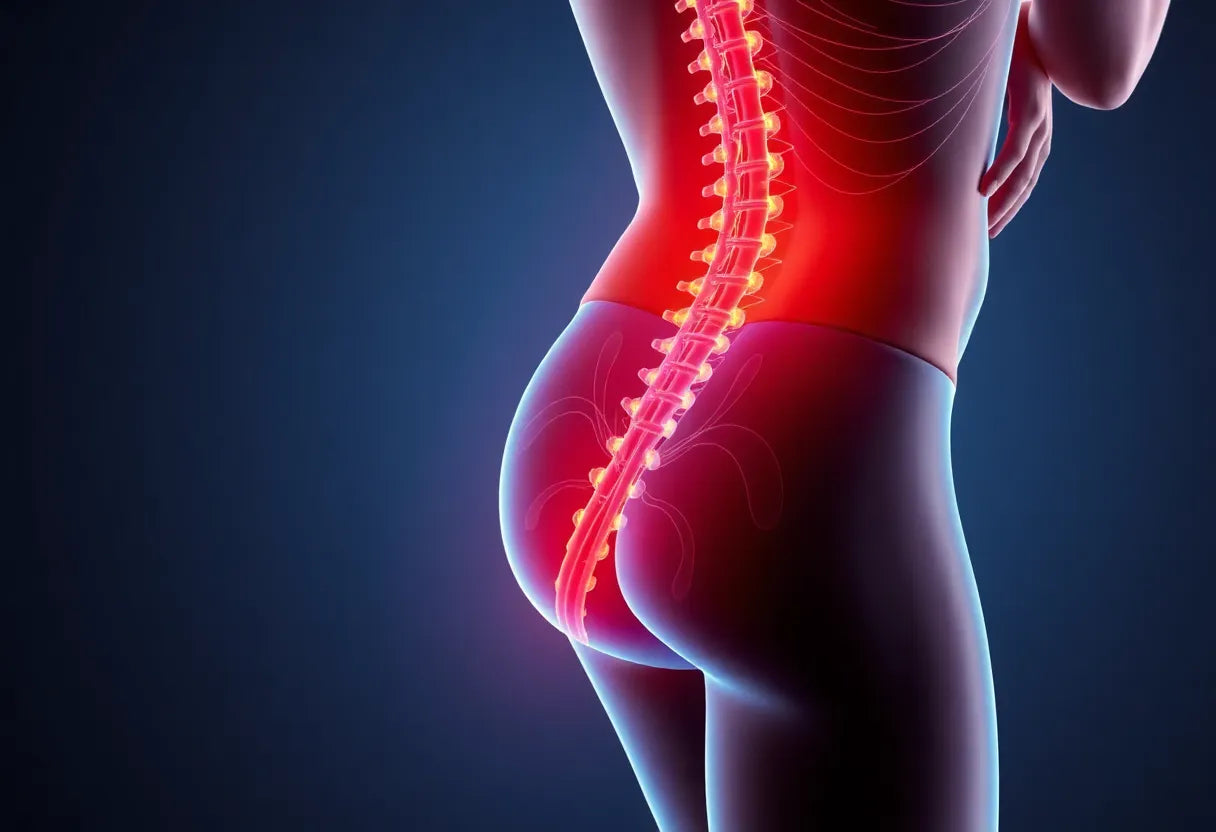Sciatica is a condition that can be as perplexing as it is painful, often leaving those affected searching for answers and relief. This condition is frequently misunderstood and misdiagnosed, yet its impact on daily life can be profound due to the debilitating pain and discomfort it causes. Understanding sciatic nerve symptoms is the first step toward managing this common issue that affects millions worldwide.
what is sciatica?
Sciatica refers to nerve pain that originates from irritation or compression of the sciatic nerve, the longest nerve in the human body. This nerve runs from the lower back, through the buttocks, and down each leg, playing a crucial role in connecting the spinal cord with the lower limbs. When something compresses or irritates the sciatic nerve, it can result in a range of symptoms that vary in intensity and duration.
overview of sciatic nerve symptoms
The hallmark symptom of sciatica is a pain that radiates from the lower back through the buttock and down the leg, often extending below the knee and sometimes reaching the foot. This pain is frequently described as sharp, shooting, burning, or resembling an electric shock. In addition to pain, individuals may experience numbness, tingling sensations, or muscle weakness in the affected leg or foot. It's important to note that sciatica typically affects only one side of the body at a time.
importance of understanding triggers
Identifying and understanding the hidden triggers of sciatic nerve symptoms is essential for effective management and prevention. The pain associated with sciatica can be exacerbated by certain activities or movements, such as prolonged sitting, coughing, or twisting the spine. By recognizing these triggers, individuals can take proactive steps to modify their activities and reduce the risk of aggravating their symptoms. Furthermore, understanding these triggers can aid in developing a comprehensive treatment plan tailored to the individual's specific needs, ultimately enhancing their quality of life.
core symptoms and characteristics of sciatic nerve symptoms
The journey of sciatic nerve pain often begins in the lower back, following a distinct pathway that can significantly impact daily activities. This pain typically radiates down through the buttock and extends along the back of the leg, sometimes reaching below the knee and into the foot. Individuals suffering from sciatica describe the sensation as sharp, shooting, burning, or akin to an electric shock. These vivid descriptions highlight the intensity and discomfort that accompany this condition.
In addition to the characteristic pain, sciatica often brings with it a suite of associated symptoms. Numbness and tingling, medically referred to as paresthesias, are common, often presenting in the affected leg or foot. Muscle weakness may also occur, contributing to a feeling of heaviness or difficulty in movement. Notably, sciatica usually affects one side of the body, although in rare cases, both sides can be involved.
Certain activities or movements can exacerbate sciatic nerve symptoms, making it crucial to identify and avoid these aggravating factors. Prolonged sitting, coughing, sneezing, or specific movements such as bending forward or twisting the spine can intensify the pain. While these activities might seem innocuous, they can significantly increase pressure on the sciatic nerve, leading to heightened discomfort.

Lumbar support belt
Provides adjustable lower back support for pain and sciatica relief.
It's important to be aware of red flag symptoms, which indicate a need for immediate medical attention. Sudden muscle weakness, particularly if it affects the entire leg, or a loss of bowel or bladder control, are serious symptoms that require urgent evaluation. These signs may suggest a more severe underlying condition that necessitates prompt intervention.
leading causes and mechanisms of sciatic nerve symptoms
The most common cause of sciatic nerve symptoms is a herniated or bulging disc. This occurs when the soft inner material of a spinal disc protrudes through a tear in its tougher outer layer, compressing one of the nerve roots that contribute to the sciatic nerve. This compression is what leads to the characteristic pain and associated symptoms.
Beyond herniated discs, other spinal conditions can also lead to sciatica. Spinal stenosis, a narrowing of the spinal canal, and spondylolisthesis, where one vertebra slips over another, can both compress the sciatic nerve. Additionally, piriformis syndrome, where the piriformis muscle in the buttock irritates the sciatic nerve, is another potential cause that mimics sciatica.
Less commonly, direct nerve injury due to trauma, tumors, or infections can lead to sciatic neuropathy. In such cases, muscle weakness, decreased reflexes, and other neurological deficits may be more pronounced. Clinical and electrodiagnostic studies can help differentiate these causes and guide appropriate treatment.
diagnostic approaches for sciatica
Accurately diagnosing sciatica involves a combination of clinical examinations and diagnostic tests. The Straight Leg Raise (SLR) test is a simple yet effective tool used by healthcare providers to provoke sciatic nerve pain. By gently raising the leg while the patient lies flat, this test can help differentiate sciatica from other causes of back pain.
A thorough physical and neurological exam is essential for assessing muscle strength, sensory loss, and changes in reflexes. These evaluations help pinpoint the affected nerve roots and determine the severity of the condition. In some cases, imaging studies such as MRI or CT scans may be necessary to visualize the spine and confirm the diagnosis.
Understanding the core symptoms, causes, and diagnostic approaches for sciatic nerve symptoms is crucial for effective management. By identifying the underlying cause and implementing appropriate interventions, individuals can find relief from the debilitating effects of sciatica and regain control over their daily lives.
differential diagnoses and sciatica mimics
While sciatica is a well-known condition, several other disorders can mimic its symptoms, making accurate diagnosis crucial. One such condition is piriformis syndrome, where the piriformis muscle, located in the buttocks, compresses the sciatic nerve. This can lead to pain that closely resembles sciatica, but the treatment approaches may differ. Understanding these nuances is essential for effective management.
In addition to piriformis syndrome, other conditions such as peripheral nerve entrapments and lumbar radiculopathy can present with similar symptoms. A comparison between these conditions and true sciatica can help in distinguishing them. For instance, while sciatica typically results from spinal issues like herniated discs, peripheral nerve entrapments may arise from compression at various sites along the nerve's pathway.
when to seek medical attention
Deciding when to seek medical attention for sciatic nerve symptoms can be challenging. In many cases, self-care measures such as rest, over-the-counter pain relievers, and gentle exercises can alleviate symptoms. However, if the pain persists beyond a few weeks, or if red flag symptoms like sudden muscle weakness or loss of bowel or bladder control occur, it is crucial to consult a healthcare provider. These signs may indicate a more serious underlying condition requiring prompt intervention.
ergonomic and lifestyle strategies
Adopting ergonomic and lifestyle strategies can play a significant role in managing and preventing sciatic nerve symptoms. Simple changes, such as using supportive seating, maintaining proper posture, and incorporating regular physical activity, can help reduce the strain on the sciatic nerve. Additionally, ergonomic aids, like those offered by Anodyne, can provide targeted support and relief, helping to manage episodes of sciatic pain effectively.

Men's Posture Shirt™ - Black
Patented shirt improves posture and may relieve back discomfort.
Frequently Asked Questions
What are the first signs of sciatic nerve symptoms?
The initial signs of sciatic nerve symptoms often include pain radiating from the lower back through the buttock and down the leg. This pain is frequently described as sharp, shooting, or burning. Numbness, tingling, and muscle weakness in the affected leg may also occur.
Can sciatica affect both legs?
While sciatica typically affects one side of the body, it can occasionally affect both legs. This bilateral involvement is less common and may indicate an underlying condition that requires medical evaluation.
How long do sciatic nerve symptoms typically last?
The duration of sciatic nerve symptoms can vary widely. For many individuals, symptoms improve within a few weeks with self-care measures. However, if the pain persists beyond this period, it is advisable to seek medical advice for further evaluation and treatment.
What home remedies can help alleviate sciatic pain?
Home remedies for alleviating sciatic pain include applying hot or cold packs to the affected area, performing gentle stretching exercises, and ensuring good posture. Over-the-counter pain relievers can also be helpful for managing discomfort.
When should I see a doctor for sciatica?
It is important to see a doctor for sciatica if symptoms persist beyond a few weeks, worsen over time, or are accompanied by severe symptoms such as sudden muscle weakness or loss of bowel/bladder control. These may indicate a more serious condition requiring prompt medical attention.
Källor
- American Medical Association. (n.d.). "What Doctors Wish Patients Knew About Sciatica."
- Stafford, M.A., Peng, P., & Hill, D.A. (2007). "Sciatica: A Review of History, Epidemiology, Pathogenesis, and the Role of Epidural Steroid Injection in Management." British Journal of Anaesthesia.
- Mayo Clinic Staff. (n.d.). "Sciatica: Symptoms and Causes."
- Mayo Clinic Staff. (n.d.). "Sciatica: Diagnosis and Treatment."
- Hospital for Special Surgery. (n.d.). "Sciatica."
- NewYork-Presbyterian. (n.d.). "Sciatica Treatment."
- Tylenol. (n.d.). "Sciatica Pain."
- Dignity Health. (n.d.). "Sciatic Nerve Pain: Diagnosis and Treatment."
- Cleveland Clinic. (n.d.). "Sciatica."
- NeuroSpine Plus. (n.d.). "Sciatica Diagnosis and Relief."
- Harvard Health Publishing. (n.d.). "Sciatica."
- UCHealth. (n.d.). "Sciatica."
- Yale Medicine. (n.d.). "Sciatica."
- MedlinePlus. (n.d.). "Sciatic Nerve Anatomy."


















